
Journal of Islamic Manuscripts
Scope & Guideline
Preserving Heritage, Illuminating Manuscripts
Introduction
Aims and Scopes
- Study of Manuscript Cultures:
The journal focuses on the rich traditions of Islamic manuscript production, including the material aspects, provenance, and cultural contexts of manuscripts across various regions. - Codicology and Paleography:
It emphasizes the examination of manuscript texts, their physical characteristics, and the historical techniques of writing and copying, contributing to our understanding of manuscript heritage. - Cultural and Historical Contexts:
The journal explores manuscripts within their broader socio-cultural and historical frameworks, shedding light on how these texts have influenced and reflected Islamic thought and practices. - Interdisciplinary Approaches:
Research published in the journal often employs interdisciplinary methodologies, integrating art history, literature, history, and religious studies to provide a comprehensive understanding of manuscripts. - Preservation and Conservation:
The journal addresses issues of preservation, conservation practices, and the challenges faced by manuscript collections, particularly in regions with endangered manuscript cultures.
Trending and Emerging
- Digital Humanities and Manuscript Studies:
There is a notable increase in research utilizing digital tools and methodologies to analyze manuscripts, reflecting the growing intersection of technology and traditional manuscript scholarship. - Regional Manuscript Traditions:
An emerging focus on specific regional manuscript traditions, such as those from Yemen, East Africa, and Central Asia, highlights the diversity of Islamic manuscript cultures and their unique characteristics. - Materiality and Textuality:
Recent papers emphasize the material aspects of manuscripts, such as binding, ink, and writing materials, alongside textual analysis, showcasing a trend towards understanding manuscripts as physical objects that carry cultural significance. - Provenance Studies:
The exploration of provenance and ownership histories of manuscripts is gaining traction, indicating a growing interest in the narratives and journeys of manuscripts through time and space. - Interdisciplinary Connections:
There is a rising trend in exploring interdisciplinary connections, particularly the relationships between manuscripts and contemporary issues such as identity, migration, and cultural heritage.
Declining or Waning
- General Manuscript Surveys:
While comprehensive surveys of manuscript collections were once prevalent, recent issues show a decline in such broad studies, suggesting a shift towards more focused and specialized research topics. - Traditional Manuscript Genres:
There appears to be a waning interest in traditional manuscript genres, such as poetry and religious texts, as scholars increasingly prioritize unique or lesser-known manuscripts and their contextual significance. - Historical Overviews of Manuscript Production:
Papers that provided general historical overviews of manuscript production practices are becoming less common, with a growing preference for in-depth case studies that highlight specific manuscripts or collections.
Similar Journals
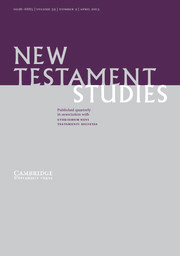
NEW TESTAMENT STUDIES
Unveiling Insights from the New TestamentNEW TESTAMENT STUDIES is a prestigious academic journal published by Cambridge University Press, dedicated to the advanced study of the New Testament and its historical context. With an ISSN of 0028-6885 and an E-ISSN of 1469-8145, this journal has established itself as a leading resource in the fields of History and Religious Studies, currently holding a Q1 ranking in both categories as of 2023. With a remarkable convergence of scholarly discourse from 1954 to 2024, the journal is noted for its rigorous peer-reviewed articles that contribute significantly to the understanding of early Christian texts. Although not an open-access publication, it provides essential access options through academic libraries, ensuring that researchers, professionals, and students alike can engage with its high-impact content. With a Scopus ranking placing it in the 80th percentile in both Religious Studies and History, NEW TESTAMENT STUDIES is an invaluable outlet for innovative research and critical scholarship that shapes contemporary biblical studies.
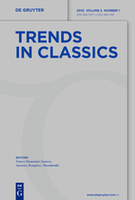
Trends in Classics
Connecting scholars to the rich tapestry of classical studies.Trends in Classics is a distinguished academic journal published by WALTER DE GRUYTER GMBH, dedicated to advancing the field of Classics through critical scholarship and innovative research. With an ISSN of 1866-7473 and an E-ISSN of 1866-7481, this journal offers a platform for scholars from around the globe to share insights on classical literature, history, and archaeology. Indexed in Scopus and awarded a respectable Q4 classification in Classics, it ranks 48th out of 170 in the Arts and Humanities category, placing it in the top 72nd percentile—an indicator of its growing influence and contribution to the field. Operating from Germany, specifically from Genthin Strasse 13, D-10785 Berlin, the journal spans converged years from 2009 to 2024, fostering ongoing dialogues and developments within classical studies. Although it does not currently offer open access, its commitment to scholarly excellence makes it a vital resource for researchers, professionals, and students alike, who seek to deepen their understanding of ancient cultures and their lasting impacts on contemporary society.

ROMANCE PHILOLOGY
Advancing Knowledge in Linguistics and Literary TheoryROMANCE PHILOLOGY is a distinguished academic journal dedicated to the exploration of language, literature, and linguistic theory within the Romance language family. Published by BREPOLS PUBL, it offers a platform for scholars, researchers, and practitioners to disseminate their findings and engage with the latest developments in these fields. The journal's impact factor reflects its standing, positioned within the Q4 category in Linguistics and Language and Q3 in Literature and Literary Theory for 2023, making it an essential resource for those studying Romance philology. Although coverage in Scopus was discontinued in 2021, the journal maintains a commitment to rigorous academic standards and comprehensive peer-review processes. With a broad scope encompassing theoretical and practical aspects of Romance languages and literatures, ROMANCE PHILOLOGY invites contributions that push the boundaries of knowledge and enrich the academic dialogue surrounding these vital areas of study. For those passionate about linguistic and literary pursuits, this journal stands as a significant gateway into the evolving discourse of Romance studies.

Manuscript Studies-A Journal of the Schoenberg Institute for Manuscript Studies
Exploring the Depths of Manuscript PreservationManuscript Studies: A Journal of the Schoenberg Institute for Manuscript Studies, published by University of Pennsylvania Press, serves as a pivotal resource in the intertwined fields of conservation, library sciences, and literature. With an ISSN of 2381-5329 and an E-ISSN of 2380-1190, the journal has been actively contributing to academic discourse since its inception in 2016 and continues to resonate through 2024. The journal is categorized in the Q3 quartiles for Conservation and Library and Information Sciences, and Q2 for Literature and Literary Theory, reflecting its relevance and credibility within these disciplines. While it is not an open-access journal, its vital scholarship is crucial for researchers and professionals dedicated to the preservation and interpretation of manuscripts. Positioned within the competitive arenas of Scopus rankings, Manuscript Studies highlights significant contributions to the understanding of manuscript collections, offering interdisciplinary perspectives that are essential for students and scholars alike. Whether delving into the complexities of textual transmission or exploring methodologies in manuscript conservation, Manuscript Studies remains an invaluable platform for advancing knowledge and fostering dialogue in the study of manuscripts.

Taida Journal of Art History
Decoding the evolution of artistic expression in Taiwan.Taida Journal of Art History, published by NATIONAL TAIWAN UNIVERSITY, GRADUATE INSTITUTE OF ART, is a pioneering academic journal dedicated to the exploration and critique of art history, particularly within the unique cultural context of Taiwan. Since its inception in 2018, the journal has become an important platform for scholarly discourse, offering insights into the evolution of visual arts and performing arts, alongside comprehensive studies in history. With an ISSN of 1023-2095, it currently ranks within the Q4 category in Arts and Humanities (Miscellaneous) and the Q3 category in History and Visual Arts and Performing Arts, indicating its growing influence in these fields. Researchers, professionals, and students alike can benefit from its rigorous peer-reviewed articles that bridge theoretical frameworks with practical applications, making it an essential resource for those engaged in the arts and humanities. This commitment to fostering academic excellence is reflected in its Scopus rankings, where it stands at Rank #338/667 in Visual Arts and Performing Arts and Rank #1027/1760 in History. Engage with the Taida Journal of Art History to gain deeper insights into the evolving narratives of artistic expression.
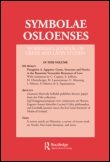
Symbolae Osloenses
Unveiling the Legacy of Ancient CulturesSymbolae Osloenses, published by TAYLOR & FRANCIS LTD, is a distinguished journal in the field of Classics, with a rich history dating back to its inception in 1922. This UK-based journal has continuously contributed to the scholarly discourse surrounding ancient cultures, languages, and literature, making it a crucial resource for researchers, educators, and students alike. Though it operates under a subscription model, its impact on the academic community is underscored by its recent inclusion in the 2023 Scopus rankings, where it holds a respectable position in the 65th percentile among its peers. With decades of published research spanning from 1924 to 2023, Symbolae Osloenses remains committed to fostering robust academic dialogue and advancing knowledge in the Classics, catering to a diverse readership seeking to explore the nuances of classical studies.

Vestnik Sankt-Peterburgskogo Universiteta-Iskusstvovedenie
Illuminating Emerging Research in the ArtsVestnik Sankt-Peterburgskogo Universiteta-Iskusstvovedenie, published by ST PETERSBURG UNIV PRESS, is a distinguished academic journal based in the Russian Federation, focusing on the interconnected disciplines of Conservation, History, Music, and Visual Arts and Performing Arts. With an ISSN of 2221-3007 and E-ISSN of 2542-2243, this journal plays a vital role in disseminating scholarly research and fostering dialogue across these fields. Despite being categorized in the third quartile (Q3) in 2023 across its respective disciplines, its significance lies in publishing emerging research and critical analyses that contribute to the academic discourse. The journal accepts submissions until the converged years spanning 2016 to 2024, making it a relevant platform for current academic inquiry. Although it currently does not offer open access, the journal provides robust insights for researchers, professionals, and students eager to explore the nuances of cultural heritage and artistic expression. As it continues to develop its impact within the arts and humanities, Vestnik Sankt-Peterburgskogo Universiteta-Iskusstvovedenie remains an essential resource for those passionate about understanding and preserving the rich tapestry of artistic endeavors.
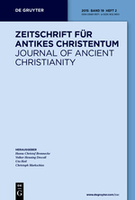
ZEITSCHRIFT FUR ANTIKES CHRISTENTUM-JOURNAL OF ANCIENT CHRISTIANITY
Connecting Past Narratives with Present InsightsZEITSCHRIFT FUR ANTIKES CHRISTENTUM - JOURNAL OF ANCIENT CHRISTIANITY is a prominent academic journal published by Walter de Gruyter GmbH, dedicated to advancing the study of ancient Christianity within the rich contexts of Classics, History, and Religious Studies. With its roots extending from 1997 to 2024, this journal has made a significant contribution to its fields, earning a noteworthy Q3 ranking in both Classics and History, and a Q4 ranking in Religious Studies as of 2023. Positioned in Germany, the journal serves as a vital platform for researchers, scholars, and students, facilitating the dissemination of innovative research and critical discourse. Although it does not currently offer open access, its rigorously peer-reviewed articles provide valuable insights and enhance the understanding of ancient Christian phenomena. The journal aims to bridge historical narratives with contemporary scholarly discussions, making it an indispensable resource for anyone interested in the evolution and impact of Christianity throughout history.
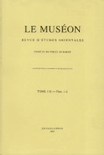
Museon
Exploring the Intersections of Thought and CultureMuseon, published by PEETERS in Belgium, is a prominent academic journal dedicated to exploring the interconnected realms of History, Linguistics, Literature, and Religious Studies. With an ISSN of 0771-6494 and an E-ISSN of 1783-158X, this journal has been a reliable source of scholarly discourse since its inception in 1972, with coverage extending from 1976 to 2023. While the journal does not offer open access, it maintains a respectable reputation, as evidenced by its category quartile rankings in 2023, positioning it in Q2 for Literature and Literary Theory and Q3 for the other disciplines. Researchers and students in these fields will find Museon to be an essential platform for disseminating and engaging with innovative and critical analyses. The journal's commitment to high-quality scholarship is reflected in its diverse scope and its ongoing contribution to the humanities, making it a vital resource for advancing knowledge and fostering academic dialogue.

Rukopysna ta Knyzhkova Spadshchyna Ukrainy-Manuscript and Book Heritage of Ukraine
Illuminating Ukraine's Historical Texts for AllRukopysna ta Knyzhkova Spadshchyna Ukrainy-Manuscript and Book Heritage of Ukraine is a prestigious academic journal dedicated to the exploration and preservation of Ukraine's manuscript and book heritage. Published by the VERNADSKY NATIONAL LIBRARY OF UKRAINE, this open access journal has been providing invaluable insights since 2010, ensuring that scholarly work is readily available to all interested parties. With its commitment to the documentation and analysis of historical texts, it serves as a vital resource for researchers, librarians, and students engaged in the fields of History and Library and Information Sciences. The journal is indexed on Scopus, reflecting its growing relevance within the academic community, with a current ranking that positions it in the Q3 and Q4 quartiles respectively for 2023. As it converges into its future expansion from 2020 to 2024, Rukopysna ta Knyzhkova Spadshchyna remains a significant platform for fostering scholarly dialogue and advancing knowledge pertaining to Ukraine's rich literary and historical legacy.